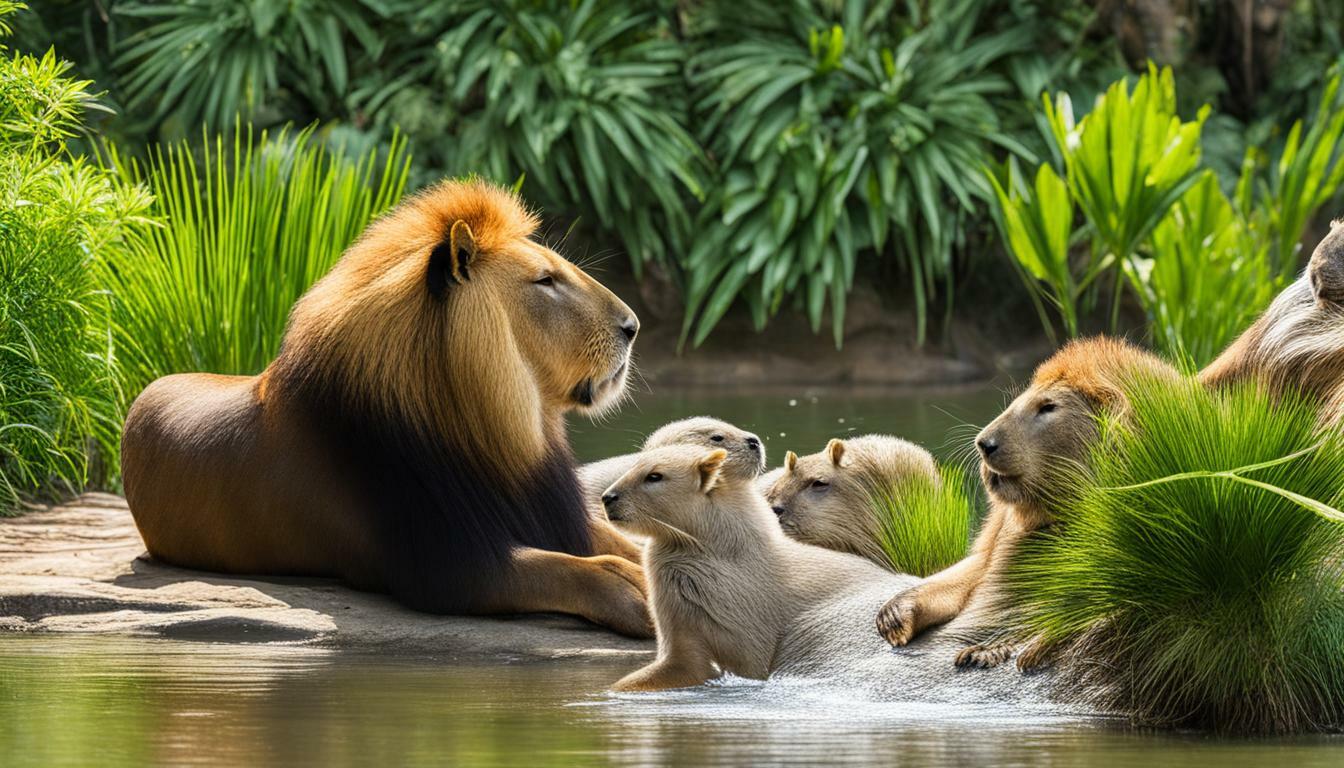Welcome to the Pittsburgh Zoo, where wildlife enthusiasts can explore a wide variety of animal exhibits. But the question on everyone’s mind is, “Does The Pittsburgh Zoo Have Capybaras?”
Key Takeaways:
- The Pittsburgh Zoo has capybaras in its collection.
- Recently, three capybaras, including one named Lysa, were added to the zoo.
- Capybaras are the world’s largest rodents and are native to Central and South America.
- They prefer marshy areas and rely on water for moisture due to their dry skin.
- The capybaras at the Pittsburgh Zoo are part of the new Jungle Odyssey exhibit.
Discover the Capybaras at Pittsburgh Zoo
Get ready to meet the adorable capybaras at the Pittsburgh Zoo! Recently, the zoo added three capybaras, including a special capybara named Lysa, to its collection of fascinating animals. Capybaras are the world’s largest rodents and are native to Central and South America. They are known for their friendly and sociable nature, making them a delight to observe.
These charismatic creatures can be found in the new Jungle Odyssey exhibit at the Pittsburgh Zoo. This immersive exhibit aims to transport visitors to different regions of the world, showcasing the diverse wildlife that inhabits them. The capybaras’ natural habitat is recreated within the exhibit, complete with marshy areas and water sources, allowing them to thrive in a setting reminiscent of their native environment.
Did you know?
The capybaras at the Pittsburgh Zoo are not only adorable but also play an important role in conservation efforts. By having capybaras as ambassadors for their species, the zoo helps raise awareness about the need to protect and preserve their natural habitats in the wild.
Visitors to the Pittsburgh Zoo can learn more about capybaras through various educational programs and events. From interactive talks to behind-the-scenes experiences, these opportunities provide a deeper understanding of these fascinating rodents and their role in the ecosystem. The zoo is committed to promoting animal welfare and environmental sustainability, ensuring visitors leave with not only fond memories but also a newfound appreciation for wildlife.
| Highlights of the Capybaras at Pittsburgh Zoo: |
|---|
| Three capybaras, including a special capybara named Lysa |
| Jungle Odyssey exhibit offers an immersive experience |
| Opportunities for educational programs and events |
| Promoting animal welfare and conservation efforts |
Don’t miss out on the chance to see these captivating capybaras during your visit to the Pittsburgh Zoo. Whether you’re a wildlife enthusiast or simply looking for a fun and educational day out, the zoo’s diverse collection of animals, including the delightful capybaras, is sure to leave a lasting impression.
The World’s Largest Rodents
Did you know that capybaras are actually the world’s largest rodents? These amazing creatures can weigh up to 150 pounds and are native to Central and South America. With their friendly and sociable nature, capybaras have captured the hearts of many animal enthusiasts.
Capybaras thrive in marshy areas, where they can find plenty of water for swimming and bathing. In fact, they rely on water to keep their skin moisturized, as they have dry skin. Their unique adaptation to an aquatic lifestyle sets them apart from other rodents. These interesting characteristics make capybaras a fascinating addition to any wildlife exhibit.
At the Pittsburgh Zoo & PPG Aquarium, visitors can now witness these extraordinary creatures as part of the new Jungle Odyssey exhibit. The zoo recently welcomed three capybaras to their collection, including a capybara named Lysa. This exhibit not only showcases capybaras but also provides a glimpse into the diverse wildlife from different regions.
Fun Facts about Capybaras:
- Capybaras are herbivores, primarily feeding on grasses and aquatic plants.
- They are highly social animals, often living in groups and displaying cooperative behavior.
- Capybaras have webbed feet, which enable them to swim effortlessly.
- Despite their large size, capybaras are excellent at hiding and can quickly disappear into the water or vegetation if they sense danger.
| Capybara Facts | |
|---|---|
| Scientific Name | Hydrochoerus hydrochaeris |
| Habitat | Marshes, swamps, and wetlands in Central and South America |
| Size | Up to 4.5 feet long and 2 feet tall |
| Lifespan | Average of 8-10 years in the wild |
Don’t miss the opportunity to see the capybaras at the Pittsburgh Zoo. With their impressive size and unique lifestyle, these remarkable creatures are sure to captivate visitors of all ages. Plan your visit to the zoo and embark on a journey to discover the wonders of the animal kingdom!
Capybaras’ Habitat and Lifestyle
Capybaras thrive in marshy areas and are well adapted to an aquatic lifestyle, relying on water to keep their skin hydrated. At the Pittsburgh Zoo, their habitat is carefully designed to replicate their natural environment. The zoo’s exhibit provides a spacious and lush area where the capybaras can freely roam and enjoy a habitat that closely resembles their native homes in Central and South America.
The capybaras at the Pittsburgh Zoo are housed in a specially created enclosure that features a large pool of water, surrounded by vegetation, rocks, and logs to mimic the marshy landscapes they prefer. This setup allows the capybaras to swim, forage for food, and bask in the sun, just as they would in the wild.
In addition to providing a suitable habitat, the Pittsburgh Zoo also focuses on the social aspects of the capybaras’ lifestyle. Capybaras are social animals and are often found in small groups called herds. The zoo ensures that the capybaras have companionship by housing them together, enhancing their well-being and allowing visitors to observe their fascinating social interactions.
| Key Features of the Capybaras’ Habitat at the Pittsburgh Zoo: |
|---|
| Large pool of water for swimming and hydration |
| Vegetation, rocks, and logs resembling a natural marshy environment |
| Open space for movement and exploration |
| Companionship with other capybaras for social interactions |
By recreating the capybaras’ habitat and lifestyle at the Pittsburgh Zoo, visitors have the opportunity to observe these unique creatures up close and learn about their behavior, conservation needs, and the importance of protecting their natural habitats.
Jungle Odyssey Exhibit
The capybaras at the Pittsburgh Zoo are part of the exciting Jungle Odyssey exhibit, which aims to provide visitors with an immersive experience of various wildlife from different parts of the world. This exhibit showcases the rich biodiversity found in tropical rainforests, making it a must-visit destination for animal enthusiasts and nature lovers.
As you explore the Jungle Odyssey exhibit, you’ll encounter a diverse range of fascinating creatures, including monkeys, reptiles, amphibians, and of course, the capybaras. These gentle giants, native to Central and South America, will captivate you with their unique characteristics and adorable appearance.
“The capybaras truly steal the show,” says Amy Johnson, the Pittsburgh Zoo’s animal curator. “They are the largest rodents in the world and have a peaceful demeanor that makes them a favorite among visitors.”
| Attraction | Description |
|---|---|
| Monkey Haven | A lush habitat featuring playful monkeys swinging from tree branches and engaging in their natural behaviors. Visitors can observe these intelligent creatures up close. |
| Reptile Retreat | An area dedicated to reptiles and amphibians, showcasing various species like snakes, frogs, and turtles. Learn about their unique adaptations and the vital role they play in the ecosystem. |
No trip to the Jungle Odyssey exhibit would be complete without visiting the Capybara Cove. Here, you can observe the capybaras in a habitat that closely resembles their natural environment. With its lush vegetation and water features, Capybara Cove recreates the marshy areas that these charming creatures call home.
Whether you’re fascinated by the capybaras or want to explore the vibrant world of tropical rainforests, the Jungle Odyssey exhibit at the Pittsburgh Zoo offers an unforgettable experience for visitors of all ages. Get ready to embark on a wild adventure and discover the wonders of nature.
Exploring the Pittsburgh Zoo
In addition to the capybaras, the Pittsburgh Zoo offers a wide range of attractions and animal exhibits that will captivate visitors of all ages. The zoo is home to over 4,000 animals representing more than 500 species, making it a must-visit destination for animal lovers.
One of the highlights of the Pittsburgh Zoo is the Jungle Odyssey exhibit, where you can find the capybaras. This immersive exhibit takes you on a journey through different regions, showcasing diverse wildlife from around the world. Explore the lush habitats and observe animals such as jaguars, tapirs, reptiles, and of course, the fascinating capybaras.
Discover the Jungle Odyssey Exhibit
| Location | Pittsburgh Zoo |
|---|---|
| Attraction | Jungle Odyssey Exhibit |
| Animals | Capybaras, jaguars, tapirs, reptiles, and more |
| Highlights | Lush habitats, educational displays, interactive experiences |
While exploring the zoo, be sure to visit other popular exhibits such as the Asian Forest, African Savanna, and Tropical Forest. Marvel at the majestic elephants, playful primates, and colorful birds that call these habitats home. The Pittsburgh Zoo offers a unique opportunity to get up close and personal with a wide variety of animals from all corners of the globe.
As you stroll through the zoo, take advantage of the educational programs and events available. Join a guided tour led by knowledgeable zookeepers, attend a wildlife presentation, or participate in hands-on activities that promote conservation and animal welfare. These programs are not only fun and engaging but also offer valuable insights into the importance of protecting our planet’s precious wildlife.
Plan your visit to the Pittsburgh Zoo today and embark on an unforgettable adventure. Experience the wonders of the animal kingdom, learn about different species, and support the zoo’s conservation efforts. Whether you’re visiting with family, friends, or on your own, the Pittsburgh Zoo guarantees a day filled with excitement, education, and appreciation for the natural world.
Plan Your Visit to the Pittsburgh Zoo
Ready to experience the wonders of the Pittsburgh Zoo and get up close with the charming capybaras? Here’s everything you need to know to plan your visit.
When it comes to attractions, the Pittsburgh Zoo offers something for everyone. From the diverse wildlife exhibits to the educational programs and events, there’s no shortage of things to see and do. One of the main highlights is the Jungle Odyssey exhibit, where you’ll find the fascinating capybaras. These captivating creatures are the world’s largest rodents and will surely leave you in awe.
Before heading to the zoo, it’s important to check the opening hours. The Pittsburgh Zoo is typically open from 9 am to 5 pm, although it’s always a good idea to verify the schedule in advance. Admission tickets can be purchased online or at the gate, with prices varying based on age and membership status. Parking is available on-site for a fee, so make sure to allocate some time for finding a convenient spot.
| Opening Hours | Admission Prices | Parking |
|---|---|---|
| 9 am – 5 pm | Adults: $18.95 Children (2-13): $16.95 Senior Citizens (60+): $17.95 |
$8 per vehicle |
Once you’re inside the zoo, be sure to check out the other attractions as well. The Pittsburgh Zoo features a wide range of animal exhibits, from big cats to aquatic creatures. Take your time to explore and learn about the various species, all while enjoying the beautiful surroundings. Don’t forget to bring comfortable walking shoes, as there’s plenty of ground to cover!
As you immerse yourself in the sights and sounds of the Pittsburgh Zoo, remember that your visit supports the zoo’s conservation efforts. By becoming a member, making a donation, or participating in fundraising events, you contribute to the welfare and preservation of animals like the capybaras. So, go ahead and plan your visit to the Pittsburgh Zoo for an unforgettable experience with the fascinating world of wildlife.
Conservation Efforts at the Pittsburgh Zoo
Beyond its role as an educational and recreational facility, the Pittsburgh Zoo is actively involved in conservation efforts, including initiatives aimed at protecting capybaras and their natural habitat. The zoo recognizes the importance of preserving biodiversity and strives to make a positive impact on wildlife conservation. Through various programs and partnerships, the Pittsburgh Zoo works tirelessly to ensure the long-term survival of capybaras and other vulnerable species.
Protecting Capybaras and Their Habitat
The Pittsburgh Zoo’s conservation efforts extend to capybaras, the world’s largest rodents. These fascinating creatures are native to Central and South America, where they inhabit marshy areas and rely on water for moisture due to their dry skin. The zoo actively supports initiatives that focus on protecting capybara populations and preserving their natural habitat. By raising awareness and conducting research, the Pittsburgh Zoo contributes to the overall understanding of capybaras and their critical role in their ecosystems.
The zoo also works closely with local communities and international organizations to implement conservation measures. Through these collaborations, the Pittsburgh Zoo aims to establish sustainable practices that safeguard capybaras and their habitats for future generations. By supporting education and awareness programs, the zoo encourages visitors to become advocates for capybara conservation and take action to protect these extraordinary creatures.
Jungle Odyssey: A New Home for Capybaras
The capybaras at the Pittsburgh Zoo are part of the newly opened Jungle Odyssey exhibit. This immersive experience allows visitors to explore a recreation of the capybaras’ natural habitat, complete with lush vegetation, interactive displays, and educational signage. The exhibit not only showcases the capybaras but also highlights the importance of preserving their habitat and the challenges they face in the wild. By providing a captivating and educational environment, the Pittsburgh Zoo encourages visitors to learn about capybaras and the need for their conservation.
| Conservation Efforts at the Pittsburgh Zoo | Key Initiatives |
|---|---|
| Capybara Research and Monitoring | Conducting studies on capybara behavior, ecology, and population dynamics to inform conservation efforts. |
| Community Outreach | Engaging with local communities to raise awareness about capybaras and promote conservation practices. |
| Partnerships | Collaborating with international organizations to support capybara conservation on a global scale. |
| Habitat Restoration | Implementing projects to restore and protect capybara habitats, focusing on wetlands and water resources. |
| Education and Advocacy | Developing educational programs and events to inspire visitors to become stewards of capybaras and their habitats. |
Educational Programs and Events
The Pittsburgh Zoo offers a variety of educational programs and events, giving visitors the chance to learn more about capybaras and other fascinating wildlife. Whether you’re a nature enthusiast or simply curious about the natural world, these engaging activities are perfect for both children and adults.
One of the highlights is the “Capybara Encounter,” where you can get up close and personal with these adorable creatures. Under the guidance of experienced zookeepers, you’ll have the opportunity to learn about their habits, observe their behavior, and even interact with them. It’s a truly unique and memorable experience that allows you to develop a deeper appreciation for these incredible animals.
In addition to the Capybara Encounter, the Pittsburgh Zoo also offers educational presentations and workshops. These informative sessions cover a wide range of topics related to wildlife conservation, animal behavior, and environmental sustainability. Led by knowledgeable experts, these programs provide valuable insights into the important work being done at the zoo and around the world to protect and preserve our planet’s biodiversity.
| Date | Event | Time |
|---|---|---|
| June 15 | Capybara Conservation Talk | 11:00 AM – 12:00 PM |
| July 5 | Wildlife Photography Workshop | 1:00 PM – 3:00 PM |
| August 20 | Animal Enrichment Demo | 2:30 PM – 3:30 PM |
Whether you’re attending one of these events or exploring the zoo at your own pace, you’ll be surrounded by a diverse array of captivating animal exhibits. From the lush rainforest of the Jungle Odyssey exhibit, where the capybaras reside, to the breathtaking underwater world of the PPG Aquarium, there’s something for everyone to enjoy.
Come visit the Pittsburgh Zoo and embark on an educational journey that will inspire a love for wildlife and conservation. With a wide range of programs, events, and exhibits, it’s an experience that will leave you with lasting memories and a greater understanding of our planet’s magnificent creatures.
Support the Pittsburgh Zoo
If you’re passionate about wildlife and want to contribute to the conservation efforts of the Pittsburgh Zoo, there are several ways you can show your support. By becoming a member, you will not only gain unlimited access to the zoo’s attractions but also help fund essential initiatives that protect and preserve endangered species.
Membership benefits include free admission, exclusive access to members-only events, and discounts at the zoo’s gift shop and cafes. Plus, you’ll receive regular updates about the zoo’s ongoing conservation projects and educational programs.
Another way to support the Pittsburgh Zoo is by making a donation. Your contribution will directly impact the care and well-being of the zoo’s animals, including the captivating capybaras. Whether you choose to make a one-time donation or become a monthly donor, your generosity will make a difference in the lives of these incredible creatures.
Ways to Support the Pittsburgh Zoo:
- Become a member
- Make a donation
- Participate in fundraising events
By supporting the Pittsburgh Zoo, you not only promote animal welfare but also contribute to environmental sustainability. Together, we can ensure a future where wildlife thrives and generations to come can experience the beauty and wonder of our natural world.
| Membership Tiers | Benefits |
|---|---|
| Individual | Unlimited admission for one person |
| Dual | Unlimited admission for two named adults |
| Family | Unlimited admission for two named adults and up to four children |
| Conservation Partner | Unlimited admission for two named adults and up to six children, plus exclusive behind-the-scenes experiences |
Conclusion
As we conclude our exploration of the Pittsburgh Zoo and its captivating capybaras, we invite you to embark on a memorable journey to this remarkable zoo and witness the incredible array of wildlife waiting to be discovered.
The Pittsburgh Zoo & PPG Aquarium, located in Pittsburgh, Pennsylvania, is home to a diverse collection of animals, including the recently added capybaras. These fascinating creatures, with one named Lysa, are the largest rodents in the world and originate from Central and South America.
Capybaras prefer to live in marshy areas and rely on water for moisture due to their dry skin. To recreate their natural habitat, the Pittsburgh Zoo has carefully designed the Jungle Odyssey exhibit, providing a suitable environment for the capybaras and showcasing a variety of wildlife from different regions.
By visiting the Pittsburgh Zoo, not only will you have the chance to observe these captivating capybaras, but you will also contribute to the zoo’s conservation efforts. The zoo is committed to protecting and preserving wildlife, and your support as a visitor, member, or donor helps ensure these efforts continue.
So why wait? Plan your visit to the Pittsburgh Zoo and immerse yourself in the wonders of nature. Explore the numerous attractions and animal exhibits, including the Jungle Odyssey exhibit, and create lasting memories while learning about the fascinating capybaras and the importance of wildlife conservation.
FAQ
Does The Pittsburgh Zoo Have Capybaras?
Yes, the Pittsburgh Zoo & PPG Aquarium does have capybaras. They recently added three capybaras, including one named Lysa, to their collection.
What are capybaras?
Capybaras are the world’s largest rodents and are native to Central and South America. They live in marshy areas and rely on water for moisture because they have dry skin.
Where can I find capybaras at the Pittsburgh Zoo?
The capybaras can be found in the new Jungle Odyssey exhibit at the Pittsburgh Zoo.
What other wildlife and animal exhibits are available at the Pittsburgh Zoo?
The Pittsburgh Zoo offers a diverse range of wildlife and animal exhibits, showcasing animals from various regions around the world. Visitors can explore the zoo’s numerous attractions and enjoy the opportunity to see a wide array of fascinating creatures.
What is the Jungle Odyssey exhibit?
The Jungle Odyssey exhibit is a new addition to the Pittsburgh Zoo, where visitors can discover a variety of wildlife from different regions. It provides a unique opportunity to observe capybaras and other animals in a simulated jungle environment.
How can I plan a visit to the Pittsburgh Zoo?
To plan a visit to the Pittsburgh Zoo, you can check the zoo’s official website for information on opening hours, ticket prices, and parking options. Ensure you don’t miss the chance to see the captivating capybaras during your visit.
What conservation efforts are undertaken by the Pittsburgh Zoo?
The Pittsburgh Zoo is dedicated to conservation efforts, including their work in protecting and preserving wildlife. This includes their commitment to promoting animal welfare and environmental sustainability.
Are there any educational programs and events related to capybaras at the Pittsburgh Zoo?
Yes, the Pittsburgh Zoo offers educational programs and events, including those related to capybaras. These programs aim to raise awareness about wildlife and provide educational opportunities for visitors.
How can I support the Pittsburgh Zoo?
You can support the Pittsburgh Zoo by becoming a member, making a donation, or participating in fundraising events. Your support is crucial in helping the zoo continue their conservation efforts and provide a safe haven for animals like capybaras.




